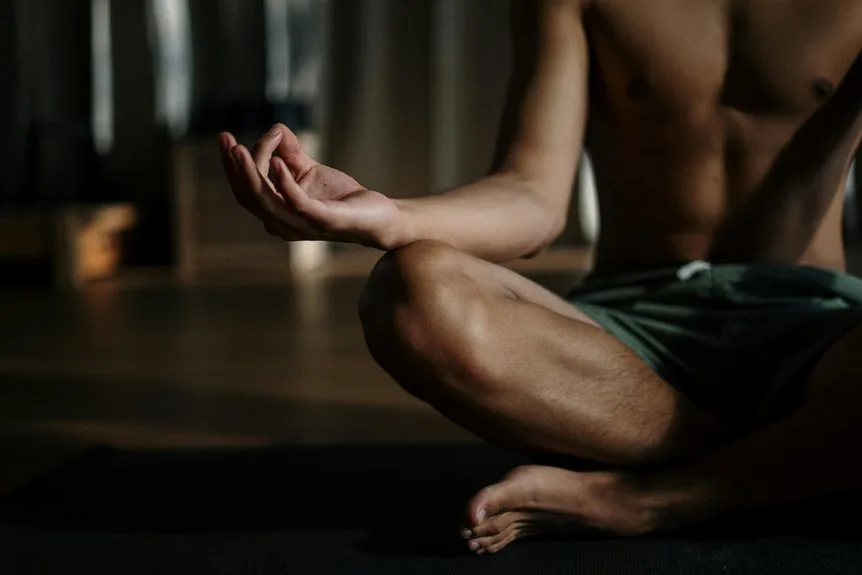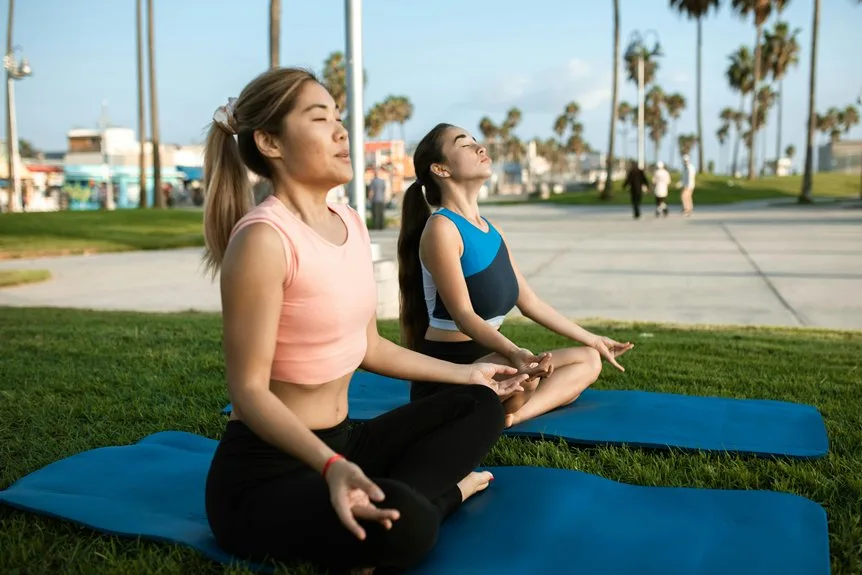Mindfulness isn’t just about meditation on a cushion; it’s woven into everyday moments. Easy practices can include taking a few deep breaths before breakfast or simply noticing the taste of your morning coffee. Even pausing to listen to the sounds around you can help ground your mind. By making small, intentional changes, anyone can create more calm and clarity throughout their day—so what are some ways to actually make mindfulness a habit?
Understanding Mindfulness and Its Benefits
What exactly is mindfulness, and why does it seem to pop up everywhere these days? Mindfulness is about tuning into the present—really noticing sensations, thoughts, and feelings as they happen, without judging them.
People turn to mindfulness because it helps reduce stress, enhances emotional stability, and sharpens focus. Scientific studies even show it can reshape the brain, making us more attentive and resilient. Quiet Mind Mountain Lodge offers mindfulness-focused retreats that emphasize relaxation and inner peace.
Mindful Wakeup: Starting Your Day With Intention
Ever wonder why mornings can feel rushed and chaotic before the day even begins? Practicing a mindful wakeup is a gentle way to anchor the body and mind before outside noise takes over.
Before reaching for a phone or email, one can sit comfortably, close their eyes, and take three nourishing breaths, feeling each inhale and exhale.
With mindfulness, it’s possible to set intentions rooted in connection, purpose, or self-identity, nurturing a sense of belonging.
Consider:
- Reflecting on how to show up positively for others
- Aligning actions with compassion and personal values
- Noticing bodily sensations to ground the present moment
For a rejuvenating experience, you might also consider visiting a premier destination like the Kenwood Inn and Spa in Sonoma County, where you can enjoy amenities such as a spa and outdoor heated pool.
Mindful Breathing Techniques for Calm
A simple yet powerful way to invite calm into a busy day is through mindful breathing. By focusing attention on the natural rhythm of each inhale and exhale, anyone can quickly connect to a sense of peace.
Even one deep breath can shift the mood, but techniques from mindfulness meditation, like box breathing, make it even more effective. Inhaling for four seconds, holding, and exhaling in equal measure helps lower stress, steady the heart, and promote emotional balance.
Regular practice not only eases anxiety but also gives a welcoming sense of belonging to the present moment, right where you are. For those looking to enhance their mindfulness experience, visiting The Springs at Borrego RV Resort offers a serene environment with stunning mountain views and access to relaxing amenities.
Mindful Eating: Savor Every Bite
Few daily routines are as familiar—or as rushed—as eating, yet shifting into a mindful approach can turn any meal into a richer experience. Practicing mindful eating starts with a body scan, checking in and rating hunger before picking up a fork. This pause, paired with 8-10 deep breaths, sets the stage for calm and connection.
Savoring each bite, noticing flavors and textures, makes meals more enjoyable and satisfying. By tuning into real hunger cues, people can build a healthier relationship with food and feel more connected at the table. Just as Wilbur Hot Springs offers a sanctuary from the fast pace and noise of modern life, incorporating mindfulness into eating can provide a respite from the hustle and bustle of daily routines.
- Pause for deep breaths and a body scan before eating
- Listen to genuine hunger signals
- Eat slowly, enjoying every mouthful
Mindful Pause: Breaking the Autopilot Cycle
Everyone slips into autopilot now and then, letting habits run the show before they even realize it. The mindful pause invites people to catch these moments, hitting the brakes just long enough to choose how they want to act instead of simply reacting.
Recognizing Automatic Behaviors
Ever notice how sometimes the day seems to go by on autopilot, with routines unfolding almost as if someone else is calling the shots? Many people find themselves moving through daily life guided by automatic behaviors, thanks to the brain’s habit of creating shortcuts for efficiency.
Mindfulness invites a gentle curiosity about these moments, helping individuals notice when the “fast brain” takes over. Recognizing these patterns can offer a sense of community in shared human experience.
- Spot repetitive actions, like checking your phone without thinking
- Reflect on moments when you react quickly or habitually
- Ask yourself what triggered an automatic response
Creating Intentional Pauses
How often does a person really stop and notice what they’re doing in the middle of a busy day? Creating intentional pauses through mindfulness means breaking the habit of running on autopilot.
Instead of rushing, people can use cues—like sticky notes or “If this, then that” signals—to prompt themselves to pause. In those moments, they can observe thoughts and feelings before reacting.
This simple pause rewires the brain, encouraging conscious choices and emotional balance. Over time, mindful pauses become easier, offering members of any community a tool to stay present, connected, and less reactive in daily life.
Mindful Listening: Tuning Into Your Environment
Mindful listening means tuning in with all your senses, picking up on sounds that usually blend into the background, like the hum of a fridge or the rustle of leaves outside.
It’s about noticing these details without rushing to judge or label them, just letting each sound be what it is.
This practice encourages a curious and open attitude, helping people respond more thoughtfully instead of reacting on autopilot.
Engaging All Your Senses
There’s something almost magical about pausing to really notice the sounds that fill a space, whether it’s the gentle hum of a refrigerator, the distant laughter of neighbors, or the soft chirping of birds outside a window.
Mindfulness, at its core, invites a person to bring full attention to these everyday moments. By engaging all the senses, mindful listening becomes a richer, more immersive experience, helping people feel more connected to their surroundings.
This simple practice can build a sense of community and calm, especially when shared with others.
- Notice layers of sound, from foreground to background
- Savor the subtle shifts in tone and volume
- Welcome each sound without labeling or judging
Noticing Hidden Background Sounds
While savoring the obvious sounds in a space can be soothing, tuning into the quieter background noises adds a whole new layer to mindfulness. Mindful listening invites people to notice sounds like the gentle hum of a fridge, leaves rustling, or distant traffic.
By focusing on these background sounds for just a minute, one can anchor awareness in the present, letting stress fade as attention sharpens. This simple act, especially when done during daily routines, helps build a shared sense of calm and connection.
Over time, mindful listening strengthens the brain’s sensory pathways, making mindfulness feel almost effortless.
Responding Without Immediate Judgment
Ever notice how easy it is to jump to assumptions the moment a new sound or conversation pops up? Mindfulness invites people to pause, paying attention to what’s actually happening before reacting or judging.
By tuning into your environment, you create space to notice details and respond thoughtfully. Mindful listening is about observing with curiosity and openness, allowing sounds to come and go without labels.
This simple shift can help cultivate a sense of belonging and calm.
- Notice sound quality—tone, volume, rhythm—without labeling as good or bad
- Observe your initial reactions, then let them go
- Practice responding with kindness and patience
Mindful Movement: Exercise With Awareness
How often does a daily workout feel more like a chore than a chance to unwind? Practicing mindful movement can help change that. By focusing on body awareness, people notice the subtle feeling of muscles stretching during yoga or the gentle pressure of feet on the ground when walking.
Coordinating breath with each movement, like inhaling with a reach or exhaling during a stretch, deepens presence. Slowing down and moving deliberately lets stress melt away. Regular check-ins for tension or discomfort encourage self-care.
Visual or physical cues anchor attention, turning exercise into a meaningful, shared experience—a moment to truly connect.
Mindful Driving: Staying Calm Behind the Wheel
Mindful driving is more than just keeping both hands on the wheel—it starts with steady breathing to keep nerves in check, even when traffic crawls.
By practicing compassion toward other drivers and noticing how frustration builds, anyone can turn a stressful commute into a chance for calm self-reflection.
Simple habits like pausing or taking a slow breath at a red light can *alter* the entire drive, making the road a more peaceful place for everyone.
Breathing Techniques for Calm
There’s something about traffic that can turn even the calmest person into a bundle of nerves, but simple breathing techniques can make all the difference behind the wheel. Deep breathing, a core mindfulness technique, invites calm by activating the body’s natural relaxation response. Focusing on the gentle rise and fall of the breath can shift attention away from frustration and toward the present moment.
Even in the middle of a jam, anyone can use these methods to create a sense of belonging on the road:
- Pause and inhale slowly for four counts, exhale for six.
- Notice the sensation of your hands on the steering wheel.
- Tune into environmental sounds without judgment.
Compassion Toward Other Drivers
Ever find yourself gripping the steering wheel a little tighter after someone cuts you off? Mindfulness behind the wheel invites drivers to pause, take a breath, and practice compassion toward other drivers, even when frustration bubbles up. Instead of reacting with anger, they can imagine the other person’s day or mistakes, letting empathy replace irritation.
Recognizing that knee-jerk reactions are just automatic brain shortcuts, drivers have the chance to choose kindness instead. Over time, observing emotions without judgment, showing patience, and extending compassion helps create a sense of community on the road—making every drive a little friendlier for everyone.
Turning Frustration Into Reflection
A red light, a line of brake lights, and the creeping sense of impatience—driving can test anyone’s nerves, especially on a busy day.
Mindfulness offers a different route: instead of letting frustration steer, drivers can pause, breathe deeply, and invite reflection.
Noticing the tension in their hands or the quickening of thoughts, they can gently shift their focus.
This isn’t just calming, it connects them to a larger sense of community on the road.
- Try three deep breaths whenever traffic slows
- Acknowledge emotions, then let them pass
- Silently wish safety for everyone sharing the expedition
Practicing Gratitude Throughout the Day
Even on the busiest days, weaving gratitude into daily routines can have a surprisingly big impact. Practicing gratitude, like noting three things you’re thankful for each morning, encourages mindfulness and helps shift focus toward the positive.
During commutes or while waiting in line, pausing to reflect on small joys can elevate mood and build a sense of connection to the world. Over time, these simple acts reduce stress and increase resilience.
People often notice better sleep and stronger relationships, feeling more connected to others. By sprinkling gratitude throughout the day, anyone can nurture a more mindful, appreciative, and supportive mindset.
Journaling for Mindful Reflection
For anyone interested in making mindfulness a regular part of life, journaling offers a surprisingly simple yet powerful tool. By spending just a few minutes each day jotting down thoughts, one can notice subtle shifts in attitude and mental clarity. Journaling encourages self-awareness, helping people become more in tune with their emotions and reactions.
Using prompts or apps makes it easy to get started, while even short entries build a sense of connection with oneself. For those who prefer alternatives, video or audio logs work just as well.
- Promotes emotional regulation and resilience
- Reinforces mindful, non-reactive responses
- Builds consistent self-awareness through reflection
Small Shifts, Big Results: Building Mindfulness Habits
Small changes often have the biggest impact, especially when it comes to building mindfulness habits. Just a minute of deep breathing or a mindful pause during a busy day can spark meaningful behavior change.
Over time, these simple acts help rewire the brain, making mindful choices feel more natural and less forced. Mindful eating or walking, for example, brings attention to everyday routines, supporting emotional balance and stress relief.
Keeping a journal to reflect on these small shifts can enhance confidence and motivation. When people see progress, even in tiny ways, they feel more connected and inspired to continue growing together.
Using Reminders and Triggers for Mindfulness
How does anyone remember to actually pause and be mindful in the middle of a hectic day? The answer is to use clever prompts and triggers that fit seamlessly into daily routines. Some people place sticky notes or a yoga mat in visible spots, while others tie mindfulness to everyday activities, like taking a deep breath when sitting down at a desk.
Rejuvenating these prompts and cues keeps the practice feeling new and engaging. Over time, these small triggers help build a sense of community around mindful living.
- Place physical prompts in high-traffic areas
- Use sensory triggers, like sounds or textures
- Rejuvenate cues regularly for lasting impact
Resources for Deepening Your Mindfulness Practice
Ever wondered where to turn when ready to take mindfulness beyond the basics? There’s a world of resources out there designed to support deeper mindfulness practices and help people connect.
Guided meditation apps like Calm, Headspace, and Insight Timer offer a huge variety of audio sessions and courses.
Online platforms such as Mindful.org and YouTube channels provide free videos and tutorials, making learning easy and accessible.
For those who crave structure, programs from Wisdom Labs and the Harvard Mindfulness Center build skills over time.
Books by experts like Jon Kabat-Zinn add perception, while community groups and virtual classes nurture support and shared growth.
Frequently Asked Questions
How Can I Practice Mindfulness Every Day?
To practice mindfulness every day, one might incorporate mindful breathing before meals or meetings and express daily gratitude. Small cues, like sticky notes, and brief mindful activities, help individuals cultivate connection and presence within their daily routines.
What Are the 5 R’s of Mindfulness?
The 5 R’s of mindfulness—Recognize, Reframe, Relax, Release, and Receive—support mindfulness meditation by encouraging present awareness, gentle breathing techniques, and emotional connection, nurturing a sense of belonging and calm within oneself and one’s community.
What Is a Simple Mindfulness Exercise That Can Be Done in 5 Minutes?
A simple five-minute mindfulness exercise involves breathing techniques and a brief body scan. Individuals focus on each breath, observe bodily sensations, and gently redirect wandering thoughts, cultivating calm and connection. This daily practice supports greater well-being and shared presence.
What Is the 15 Minute Mindfulness Activity?
The 15-minute mindfulness activity is a life-changing ritual, guiding individuals through breathing techniques and a gentle body scan. This shared practice promotes a deep sense of community, inviting everyone to experience calm, clarity, and emotional connection together.
Final Thoughts
Incorporating easy mindfulness practices into daily life can make a big difference—just eight weeks of regular mindfulness has been shown to reduce stress and enhance happiness, according to Harvard researchers. With simple steps like mindful breathing or savoring breakfast, anyone can start cultivating a calmer mind. It doesn’t require hours of meditation or fancy tools, just a willingness to pause, notice, and enjoy the present moment. Who knew being present could be so powerful?







